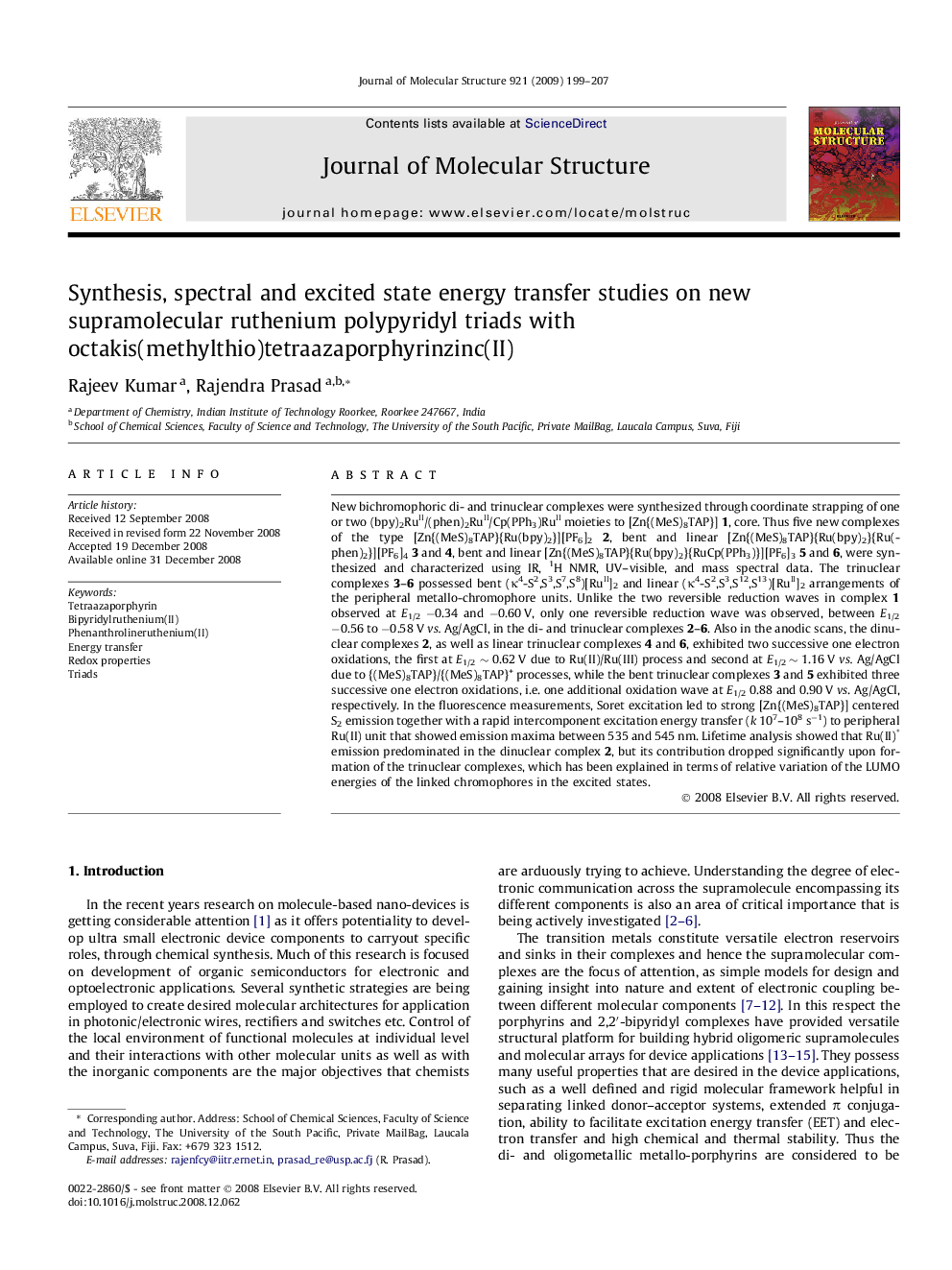| کد مقاله | کد نشریه | سال انتشار | مقاله انگلیسی | نسخه تمام متن |
|---|---|---|---|---|
| 1410344 | 1501867 | 2009 | 9 صفحه PDF | دانلود رایگان |
عنوان انگلیسی مقاله ISI
Synthesis, spectral and excited state energy transfer studies on new supramolecular ruthenium polypyridyl triads with octakis(methylthio)tetraazaporphyrinzinc(II)
دانلود مقاله + سفارش ترجمه
دانلود مقاله ISI انگلیسی
رایگان برای ایرانیان
کلمات کلیدی
موضوعات مرتبط
مهندسی و علوم پایه
شیمی
شیمی آلی
پیش نمایش صفحه اول مقاله

چکیده انگلیسی
New bichromophoric di- and trinuclear complexes were synthesized through coordinate strapping of one or two (bpy)2RuII/(phen)2RuII/Cp(PPh3)RuII moieties to [Zn{(MeS)8TAP}] 1, core. Thus five new complexes of the type [Zn{(MeS)8TAP}{Ru(bpy)2}][PF6]22, bent and linear [Zn{(MeS)8TAP}{Ru(bpy)2}{Ru(phen)2}][PF6]43 and 4, bent and linear [Zn{(MeS)8TAP}{Ru(bpy)2}{RuCp(PPh3)}][PF6]35 and 6, were synthesized and characterized using IR, 1H NMR, UV-visible, and mass spectral data. The trinuclear complexes 3-6 possessed bent (κ4-S2,S3,S7,S8)[RuII]2 and linear (κ4-S2,S3,S12,S13)[RuII]2 arrangements of the peripheral metallo-chromophore units. Unlike the two reversible reduction waves in complex 1 observed at E1/2 â0.34 and â0.60 V, only one reversible reduction wave was observed, between E1/2 â0.56 to â0.58 V vs. Ag/AgCl, in the di- and trinuclear complexes 2-6. Also in the anodic scans, the dinuclear complexes 2, as well as linear trinuclear complexes 4 and 6, exhibited two successive one electron oxidations, the first at E1/2 â¼ 0.62 V due to Ru(II)/Ru(III) process and second at E1/2 â¼Â 1.16 V vs. Ag/AgCl due to {(MeS)8TAP}/{(MeS)8TAP}+ processes, while the bent trinuclear complexes 3 and 5 exhibited three successive one electron oxidations, i.e. one additional oxidation wave at E1/2 0.88 and 0.90 V vs. Ag/AgCl, respectively. In the fluorescence measurements, Soret excitation led to strong [Zn{(MeS)8TAP}] centered S2 emission together with a rapid intercomponent excitation energy transfer (k 107-108 sâ1) to peripheral Ru(II) unit that showed emission maxima between 535 and 545 nm. Lifetime analysis showed that Ru(II)â emission predominated in the dinuclear complex 2, but its contribution dropped significantly upon formation of the trinuclear complexes, which has been explained in terms of relative variation of the LUMO energies of the linked chromophores in the excited states.
ناشر
Database: Elsevier - ScienceDirect (ساینس دایرکت)
Journal: Journal of Molecular Structure - Volume 921, Issues 1â3, 17 March 2009, Pages 199-207
Journal: Journal of Molecular Structure - Volume 921, Issues 1â3, 17 March 2009, Pages 199-207
نویسندگان
Rajeev Kumar, Rajendra Prasad,